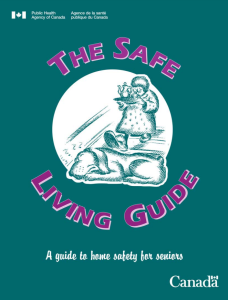Where are older people aging?
Distributions and living locations for older people vary for a number of different reasons. It’s important to consider and include are where older people are aging within a given context (e.g. city, province/state, country). Important factors to consider may include ethnicity or cultural background, resource availability (housing, healthcare, etc.) and social economic status. All of these factors intersect and play in an important role in an older person’s life and ability to age well or age in place. As an example, the infographic below provides a snapshot of where seniors live in Canada.

Activity
Consider where older people are aging in your context. What are the socioeconomic conditions? Age of the houses/neighborhoods? Ratios of age groups? Ethnicity? Level of immigration?
How do these factors relate to the WHO Age-Friendly Cities Guide for housing (p.30)
Included in the conversation about where older people are aging are the benefits and barriers to their preferred choice. This should include a connection to contexts such as how one’s history, culture, gender, physical (dis)ability and/or available resources. The following are helpful resources on this topic:
- Brim, B., Fromhold, S., & Blaney, S. (2021). Older Adults’ Self-Reported Barriers to Aging in Place. Journal of Applied Gerontology, 40(12), 1678–1686. doi: 10.1177/0733464820988800
- Kuryk, K., Funk, L. M., Warner, G., Macdonald, M., Lobchuk, M., Rempel, J., … Keefe, J. (2023). Ageing in place with non-medical home support services need not translate into dependence. Ageing and Society, 1–26. doi:10.1017/S0144686X23000478
- Martin, D., Long, O., & Kessler, L. (2019). Planning for Aging in Place: Incorporating the Voice of Elders to Promote Quality of Life. Journal of Housing For the Elderly, 33(4), 382–392. https://doi.org/10.1080/02763893.2019.1593280
Activity
To better understand benefits and barriers, view the following video created by The Senior Circle: https://www.youtube.com/watch?v=mMwjjKMhxhg
After watching the video, reflect on the following questions:
- Are there any other benefits not mentioned?
- How do equity, diversity, inclusion and accessibility contribute to producing benefits or creating barriers?
Activity
Activity
Age Friendly Walking Tour
To understand the age-friendliness of a neighborhood, choose a walking route in your neighborhood and complete one of the checklists provided below:
- Understanding Your Community: An age-friendly checklist (Winterton & Brasher, 2020)
- Checklist of Essential Features of Age-friendly Cities (World Health Organization, 2007)
- Age Friendly Parks Checklist (Age Friendly London, n.d.)
Connect to a case story
How are the people in the case story aging well in their current context?
Consider factors such as their preferences in location, sustainability, and available supports.
Connect to a case story
From the information provided in the case story, complete the home safety checklist from the activity above.
Consider how their culture/ethnicity, preferences, gender, resources and (dis)ability contribute to the safety of their home. Also take into account if they have access to resources to improve the safety of their home.
Are there any areas missing from the checklist that could improve their safety and ability to age well in place?
Additional Resources
A Guide to Aging in Place (https://www.caring.com/caregivers/aging-in-place/)
Older Adult’s Preparedness to Age in Place (https://deepblue.lib.umich.edu/bitstream/handle/2027.42/172128/0268_NPHA-Aging-in-Place-report-FINAL.pdf?sequence=4&isAllowed=y)
AARP Home Fit Guide (https://www.aarp.org/livable-communities/housing/info-2020/homefit-guide-download.html)
Golant, S. (2011). The quest for residential normalcy by older adults: Relocation but one pathway. Journal of Aging Studies. 25(3).
Hou F. & Ngo A. (2021). Differences in living arrangements of older seniors by mother tongue. Statistics Canada, Ottawa. Retrieved Jan. 15. https://www150.statcan.gc.ca/n1/pub/36-28-0001/2021005/article/00003-eng.htm
Miller, G. (2017). No Place to Grow Old: How Canadian Suburbs Can Become Age Friendly. Institute for Research on Public Policy. Ottawa: Canada. https://irpp.org/research-studies/no-place-to-grow-old/
Media Attributions
Image 1: Kroll, L. (2015). Geriatric Profile of Canadians [infographic]. Available at https://www.behance.net/gallery/23287799/Geriatric-Profile-of-Canadians.
Image 2: Public Health Agency of Canada. (2015). The Safe Living Guide. Ottawa, Canada; Public Health Agency of Canada. Available from https://www.canada.ca/content/dam/phac-aspc/migration/phac-aspc/seniors-aines/publications/public/injury-blessure/safelive-securite/pdfs/safelive-securite-eng.pdf

